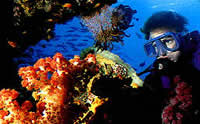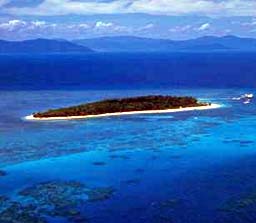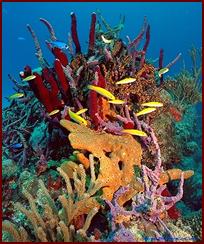Great Barrier Reef
World Heritage Listed
Marine Park
The Great Barrier Reef is one of, not only Queensland's but Australia's natural phenomena. Not only does it amaze and enchant the senses, it casts a spell over all those who travel from near and far to enjoy it. The amazing wonder that is, "The Great Barrier Reef" stretches through the sapphire blue waters of Queensland for over 2000 kilometres. It is the most extensive coral reef system in the world. From Bundaberg in the south, to beyond Cape York in the Tropical North , it is also the largest World Heritage Listed area, not to mention one of the largest structures made completely by living organisms. |
SCUBA Diving on the |
The Great Barrier Reef is not a single reef, but features more than 2900 individual reefs and 900 Islands. Some of these islands are deserted while others are small bare Sand Cays, Permanently Vegetated Cays and Continental Islands. The divinely warm waters off the North Queensland coast offer some of the best fishing and diving in the world. Diving the Great Barrier Reef will introduce you to a breathtaking "never seen before" underwater world of thousands of brilliantly coloured species of marine life including 1500 types of fish, 4000 types of molluscs, 350 types of echinoderms and 350 types of corals. This diversity creates a kaleidoscope of colour for divers, snorkeller's, and people viewing from underwater observatories and glass-bottomed boats. |
The Great Barrier Reef Marine Park |
Average water temperatures on the reef range from around 22'C in July to around 27'C in January making it perfect for diving and snorkelling all year round. The Reef is also the breeding ground for a large number of our rare and endangered species. The humpback whales swim up from the Antarctic to give birth to their young in our warmer reef waters, six of the world's seven species of sea turtle breed on the reef and lay their eggs on our beaches, and dugong make their homes among the sheltered seagrass beds.
"The Great Barrier Reef " would have to be considered one of Australia's major tourist destinations where many visitor's come in large numbers to experience it, and high-speed catamarans can now take you to many more isolated areas, which previously were only seen by a privileged few. The tour operators now have to observe strict guidelines relating to the number of tourists and the activities enjoyed in order to ensure this precious and fragile natural attraction is preserved,that is why an Environmental Management Charge (ECM) is levied by the Australian Government for all adults and children four years and over entering the Great Barrier Reef World Heritage area, The (ECM) is currently $4 aud per person per day, to a maximum of $12 aud per person. You should check with your travel agent or tour operator for payment collection details at the time of booking. |
The natural beauty of |
Getting to the Great Barrier Reef




